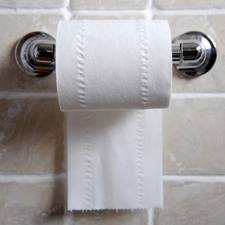Of all the frivolities of modern culture, one of the most intriguing is the debate about what the correct position should be of toilet paper rolls. In surveys noted on Wikipedia, the "over" advocates always win out over the "under" faction, but the difference is not usually very great. More interesting, perhaps, are the reasons that people give for their preferences.
When I was growing up, our family invariably loaded the toilet roll over. When we visited other people's houses, I often noticed that the rolls were mounted under, and I was puzzled as to why this would be. I think my parents believed that people who mounted it under were being pretentious, as if under were a sense of exaggerated appropriateness--perhaps what we would today call political correctness. People who did under were more inhibited, perhaps more embarrassed by normal bodily function, who liked to conceal such things as much as possible. Going "under" meant a kind of subtly more faux polite attitude towards elimination, and a moral unctuousness that was almost religious in its aspect. Since, in our family, priggishness was frowned on, we tended to regard such behavior with private amusement.
On the one hand, any earnest preference for one over the other might seem silly, since the actual effect of the difference is inconsequential. The social meaning of such distinctions is the subject of study by sociologists and psychologists, who measure the significance of such choices as clues or symptoms of behavior, towards a higher understanding of culture generally. But the process has its amusing side.
Since bathroom behavior (and bathroom facilities) aren't something people normally talk about, the isolate opinions that people formulate on an individual level may tend to be eccentric or odd. Training and habit play a part, but it's when people speculate about the coded justifications for preference, that they may reveal things about themselves that they were hardly aware of.
Of greater interest to me personally, has been the evolving technology of public facility appliances, the structure of bathrooms, of toilets, sinks, soap dispensers, and hand-drying devices. I seldom used such facilities when young, except in school restrooms. (Not many people rest in bathrooms, which is why calling them restrooms is evasive, something our puritanical ethos seems to demand.)
The new brands of toilet paper dispensers seem to be designed to reduce the cost of paper usage, as well as the frequency of servicing them. The new ones I've seen are variations on the example shown below. They carry very big rolls, but prevent the user from accessing them except from a thin slit in the bottom. Some have two rolls, one on each side. What they all seem to have in common is that the paper is much narrower than traditional paper rolls, and it's not easy to pull enough out to accomplish the task. I've had fantasies of "institutional" toilet paper getting stingier and stingier, until it's about an inch wide. That would make using it nearly impossible, which would seem to be the ultimate end of these new design trends. Also, of course, the paper is thinner than ever, and even a bit rough. This makes it difficult to break evenly; and it tends to twist; and it can't be folded easily. All of which seems, as I say, very intentional. They don't want you to feel comfortable using it--that's the point. "Don't use the toilet paper!"
I remember reading an account once about W.H. Auden, who lived a life of noble poverty, telling a visitor once (seriously), who was heading for the bathroom in his apartment, "only one section of tissue allowed!"
Soft paper products are one of the marks of a civilization. We're blessed to have Kleenex and soft toilet tissue to use. In Russia and China and South America and Africa, such things are true luxuries. Perhaps it's true, as a poet I once met at Iowa told me, peeing outdoors is "healthy" (healthier than urinating inside, into a toilet). In many parts of the world, the "conveniences" are much less up to date than one might expect. When we lived in Japan, we experienced that culture's notion of dumping into an oval opening in the floor--something which, if you haven't tried it before, can present a real challenge. I've never used a bidet, but I can see how it might be a mark of higher hygiene, particularly in a society where regular bathing isn't a frequent routine.
Over or under, we're privileged to have toilet tissue at all, and we should be grateful for it, no matter how it's dispensed. For myself, I prefer a free-standing roll, which I can dispense in any way I choose. And I also prefer to use the "disabled" toilets in public, since they provide enough room to remove your coat, without dropping your sunglasses or wallet into the bowl, and the inward opening door doesn't force you back against the flushing appliance when you're trying to exit.




2 comments:
The right(smart) way = to not hang any Toilet Paper at all because Toilet Paper is obsolete! With modern plumbing people should be cleaning with water not smearing with paper and the best way to do that is with a Hand Bidet Sprayer. Better than a Bidet it requires no new plumbing so it can go in any bathroom and actually does a better job cleaning you. See bathroomsprayers.com.
Thank you so much for this wonderful article really!
Post a Comment